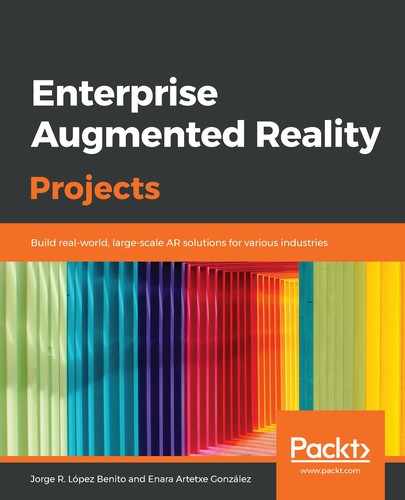Chapter 1, Introduction to AR and How it Fits the Enterprise, starts off the book by introducing AR and its uses. It covers the origins of the technology, types of AR that can be developed, the frameworks you will be using through the book, and the main uses of AR in different enterprise sectors.
Chapter 2, Introduction to Unity for AR Development, is an introduction to the real-time 3D development platform Unity, where you will learn the nomenclature and uses of the main elements. You will also learn how to create a first script in C# to see the potential of this tool.
Chapter 3, AR for Manufacturing with ARCore, introduces the ARCore technology and how to implement its surface detection features. You will create a prototype viewer for Android using Android Studio and the Sceneform plugin, which will help us to easily integrate 3D models in our project.
Chapter 4, AR for Training with WebAR and Augmented Class!, explores two different tools in a common project for training purposes. With WebAR, you will learn how to develop a simple web app that includes the <model-viewer> web component, which will be used to launch AR from an ARCore-supporting mobile device. Augmented Class! is an authoring tool for Android that's used to easily create interactive educational AR projects.
Chapter 5, AR for Marketing with EasyAR, introduces you to using Unity to develop AR projects with the EasyAR framework. You will learn how to develop an augmented catalog based on image tracking and how to create interfaces in Unity and link them to scripts and objects in the scene.
Chapter 6, AR for Retail with Vuforia, teaches you how to use Vuforia's ground detection features inside Unity to place 3D objects over flat surfaces and move/rotate/scale them, with the possibility of adding ARCore on top of Vuforia. All the while, you will work further with Unity and its components to reinforce previous concepts.
Chapter 7, AR for Automation with Vuforia and AR Glasses, continues developing with the Vuforia framework but oriented in this case to building on AR glasses. You will learn about the similarities and differences between mobile and glasses-oriented apps while creating an augmented guide for an automation process.
Chapter 8, AR for Tourism with ARKit, developed over Xcode and aimed at iOS devices. In this chapter, you will create an augmented portal anchored to the real world that will transport the user to a hidden virtual world. To do this, you will also learn how to work with the SceneKit framework to create 3D scenes and display 3D models.
